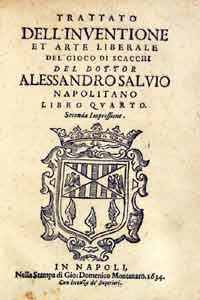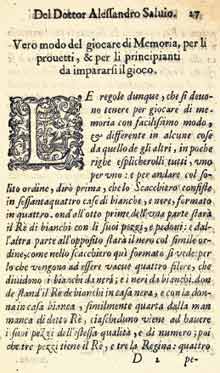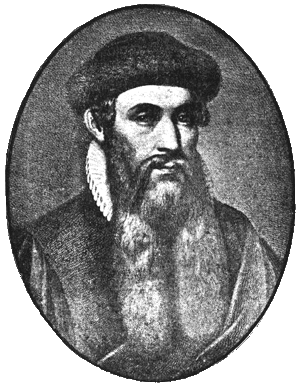 The printing press had been around since the 6th century beginning during the Sui Dynasty in China, moveable type since the 11th century and moveable metal type since shortly before Gutenberg was born. So, Gutenberg (1398 - 1468) invented neither the printing press nor the moveable type and he used inks and papers that had already been employed. His glory lies in his refinement of all these things and in adapting them in such a way to make printing commercially viable. He was more a Henry Ford than a Thomas Edison. Johannes Gensfleisch zur Laden zu Gutenberg was trained as a goldsmith, where he learned about metals, tempering, dies and presses, how to cast. He later applied this education to his printing process. Although a lot is known about Gutenberg's life, precious little is known about the very thing that made him famous, his printing methods. What is known is that he did indeed establish a printing method that worked and which spread rapidly across the continent. Printing was a very expensive undertaking. Gutenberg's venture was backed by a local, Mainz business man named Johann Fust using his equipment and contracts, basically his entire business, as collateral . When Gutenberg defaulted on his loan, after he had printed his famous Gutenberg or Mainz Bible, Fust took over his business. According to The Printing Shop of Fust and Schoeffer:  "Gutenberg's bible was a huge undertaking by any day's standards, but particularly by those in the mid 1400's. Setting each letter by hand, placing each sheet in the press and then taking it out to dry only to insert it again to be printed on the reverse side, was a
mammoth undertaking. The bible consisted of 641 sheets with most of its pages containing forty-two lines in two columns. All in all there were 1,282 pages bound in two volumes. In 1474 an account was written that described Gutenberg as printing three hundred sheets a day using six presses. About three hundred copies were printed with the binding done elsewhere and some copies being sold as separate sheets. The bible was printed in ten sections which means that Gutenberg had to have enough type to set up about 130 pages at a time. He translated into nearly four hundred thousand pieces of type needed, a huge investment of time and metal."
"Gutenberg's bible was a huge undertaking by any day's standards, but particularly by those in the mid 1400's. Setting each letter by hand, placing each sheet in the press and then taking it out to dry only to insert it again to be printed on the reverse side, was a
mammoth undertaking. The bible consisted of 641 sheets with most of its pages containing forty-two lines in two columns. All in all there were 1,282 pages bound in two volumes. In 1474 an account was written that described Gutenberg as printing three hundred sheets a day using six presses. About three hundred copies were printed with the binding done elsewhere and some copies being sold as separate sheets. The bible was printed in ten sections which means that Gutenberg had to have enough type to set up about 130 pages at a time. He translated into nearly four hundred thousand pieces of type needed, a huge investment of time and metal."
Johannes Gutenberg, the man who started a literary revolution, lived the remainder of his life possibly as a courtier to the Archbishop of Mainz then later off a small stipend from the town. He died in 1468 and was buried in the town's Franciscan Churchyard. References: Renaissance Secrets Gutenberg's Printing Press Gutenberg and the Printed Book The Printing Shop Gutenberg @ learner.org Renaissance Reflections 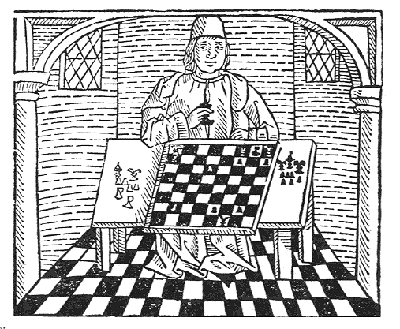 Somewhere between 1275 and 1300 Frà Jacopo de Cessole (Jacob Cessolis), a Dominican Friar, wrote a book called De Ludo Scachorum or De Moribus Hominum ed de Officiis Nobilium Super Ludo Scaccorum which is latin for simply About the Game of Chess or About the Customs of Men and the Noble Actions Involving the Game of Chess.
Somewhere between 1275 and 1300 Frà Jacopo de Cessole (Jacob Cessolis), a Dominican Friar, wrote a book called De Ludo Scachorum or De Moribus Hominum ed de Officiis Nobilium Super Ludo Scaccorum which is latin for simply About the Game of Chess or About the Customs of Men and the Noble Actions Involving the Game of Chess.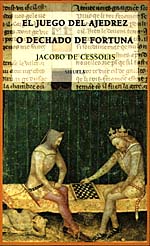
This book is a series of sermons metaphorically using chess to depict the relationships between a King and the various estates of his Kingdom. The complicated metaphor was useless for those who didn't play the game, so the author gave detailed instructions concerning the rules of chess as it was played in the 13th century. For all its moralization, the main interest of the text today are these instructions. It was during the 14th century that this book was translated from the original Latin into Catalan, Dutch, English, French, German and Italian. It was translated into French and printed in Toulouse in 1476. The picture on the right is a Spanish edition By the photograph below one can see the title, The Game of Chess. But this book is also referred to as The Game and Playe of the Chesse.  De Ludo Scachorum was first translated into French in 1347. In 1474, 2 years before it was printed in French, William Caxton translated the text from the French (of Jean de Vignay) into English and printed it under the title, The Game of Chess. The Game of Chess was the second book printed in the English language. The first book, also printed by Claxton was The Recuyell of the Historyes of Troye, also translated from French (of Raoul le Fèvre) and also in 1474. Caxton printed almost 100 books, and of these 20 were translations from French or Dutch into English. The Game of Chess has the second distinction of being the first book to be reprinted! The second printing of the book in 1483 had an interesting sidebar. It was printed in Westminster. The first edition was printed in Bruges where Caxton had been politically involved in the local merchant's association. He had ingratiated himself with Margaret, the Duchess of York, the sister of King Edward IV - in fact it was under her urging that he translated The Recuyell of the Historyes of Troye to begin with. The book was dedicated to Edward's son and Margaret's brother - George, Duke of Clarence by his humble and unknown servant, William Caxton. Claxton set up a press in Westminster in 1476 and, when in 1483 he reprinted the book, he praises the book in the dedication for it's moral value and ...woodcut illustrations but doesn't mention George who happened to have been beheaded for treason in 1478. Here's the story as described by The Cambridge History of English and American Literature (vol. XIII, ch. 3): The first book printed in the English language was the Recuyell of the Histories of Troy, issued, about 1475, at Bruges. The French original was compiled in the year 1464 by Raoul le Fevre, chaplain to Philip, duke of Burgundy, and, four years later, Caxton began to translate it into English; but, disheartened, as he tells us in his prologue, by his imperfect knowledge of French, never having been in France, and by the rudeness and broadness of his English, he soon laid the work aside. Encouraged by Margaret, duchess of Burgundy, he, later, resumed his task and finished the work in 1471. His knowledge of French was not perfect, as may be seen from occasional curious mistranslations, but his position must have required an adequate knowledge of the language. So, too, with his English. His education had been good, and he had served as apprentice with one of the most prominent of London citizens; so that he had every opportunity to acquire good English and lose his provincialisms. Nearly all his literary work consisted of translations, but, to most of his publications, he added prologues or epilogues which have a pleasant personal touch, and show us that he had one valuable possession, a sense of humor.It seems possible, though not completely certain that Cessolis got his material from an earlier compilation of sermons written in 1252 called The Innocent Morality, supposedly written by Johannes Gallensis (aka John of Wales). But it's also been attributed to Pope Innocent III (where it gets it's title). The Innocent Morality, ironically perhaps was printed in French in 1470 and is the first time the term for Chess is seen in a printed book. References: Role of the Queen in the Writings of Jacobus de Cessolis The Innocent Morality The first book printed in English Medieval Woodcuts Old Texts by Bill Wall Old Books Cessolis/Caxton Stamps Caxton'sPrologues Printing in England William Caxton William Caxton 2 There were two original chess authors in the 15th century and appropriately enough, they signified the transition from old chess to new chess. 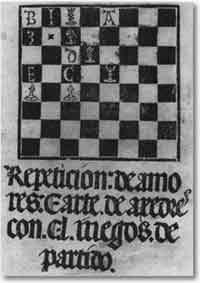 Francesch Vicent wrote a book entitled, Libre dels Jochs Partits dels Schacs en Nombre de 100 which was printed in Valencia, Spain. Only the title-page has been preserved, bearing the date May 15, 1495. The second book, Repeticion de Amores e Art de Axedrez con CL Juegos de Partido, by Luis Ramirez Lucena was published in 1497. Francesch Vicent wrote a book entitled, Libre dels Jochs Partits dels Schacs en Nombre de 100 which was printed in Valencia, Spain. Only the title-page has been preserved, bearing the date May 15, 1495. The second book, Repeticion de Amores e Art de Axedrez con CL Juegos de Partido, by Luis Ramirez Lucena was published in 1497.These two books are obliquely related and equally significant, though, because Lucena's book survive, it's has maintained a greater relevance. Both books were authored by Spaniards and printed by German printers in Spain. There had been some confusion concerning the publisher of Vicent's book. His name was Lope de Roca "Alemany". He was a famous printer even in his day. "de Roco" is the Spanish form for the German "Stein". He started his printing career in Murcia in 1487, the moved to Valencia where he died in 1498. In later years, Alessandro Salvio 1575-1640, author of Trattato dell'Inventione et Arte Liberale del Gioco Degli Scacci published in Napoli in 1604; authored a tragic poem about chess, La Scaccaide; authored Il Puttino, Altramente detto il Cavaliere Errante, an account of Leonardo da Cutri; defeated Pablo Boi and started an Italian chess academy in Napoli - Il Trattato and Il Puttino were republished in 1724 under the title, Il Gioco Gegli Scacchi del Dr. Alessandro Salviowould mistakenly refer to Alemany as the author of this book. Lope de Roca, a master printer, was friends with Petrus Hagenbach and Leonard Hutz, a printing team in Valentia. In 1496 the team split and Hutz moved to Salamanca where he teamed up with Lope Sanz to print a series of books, one of which was that of Lucena (Hagenbach became a successful printer in Toledo). The important element of this is that Lucena and Vicent used the new moves - those of the Queen and Bishop, called de la dama by Lucena - of modern chess without ignoring del viejo, the old rules. This is known directly in the case of Lucena's book and by reference in the case of Vicent's book. Lucena's book contains 10 openings, 150 positions or problems illuminated by 160 excellent woodcut illustrations. Some of these positions are identical with those in the Gottingen Manuscript (circa 1490 - a 33 page quarto parchment written in Latin containing twelve openings and thirty chess problems with solutions), leading historians to believe that Lucena was the likely author of that important work (as well as of the less famous Paris Manuscript). About Vicent's book, we know it contained 100 problems, was written in Catalan and published in Valentia. It was mentioned by Francisco Méndez in Spanish Typographia in 1796 to be a part of the in the library of the Benedictine monastery of Montserrat. But it disappeared in 1811 when the Napoleon's troops who commandeered the monastery at Montserrat and used old manuscripts and parchments from its library in the manufacturing of bullets. The possibility of the existence of another copy is so delicious to chess historians that the great Von der Lasa traveled to Spain many times searching for it, enlisting the aide of everyone who dealt in antiquities. One book dealer (J. Pin in 1912) went so far as to say, "Vicent is an author who has become famous by a book that nobody knows". References: Early Chess Players Rocky Mt. News Tribute To Dr. Ricardo Calvo Bill Wall's Earliest Chess Books and References The Old Texts Vicent Y Su Misterioso Libro de 1495 16th Century Chess Literature By the beginning of the 16th century, the new Queen and Bishop were well accepted in Spain and the option of moving the pawn 2 squares on the first move was common - as demonstrated in the Valencian poem Eschacs d’amor which was written probably around 1490. This is a manuscript, not a printed book but it's importance lies in its revelations not in its influence. Castling and Queening of pawns were still in the future but for all intents and purposes, modern chess had arrived. Eschacs d’amor is very important historically because it contains the first recorded instance of a chess game using modern moves. The poem was a joint effort among three Valencian poets: Francí de Castellví, Narcís Vinyoles and Bernat Fenollar who each play the part of Mars, Venus and Mercury respectively in the 576 lined poem. In the poem Mars is playing Venus for her love in a game of chess while Mercury arbitrates. All three of these men were active members in the literary and chess circles in Valencia and because of that a lot is known about them and because a lot is known about them, this work is a key element to understanding the origins of modern chess. The game itself was probably manufactured for the purpose of the poem. The game contains 21 moves for white and 20 for black - a ply count of 41. The poem contains 21 stanzas: Mars with the red pieces, has 21 stanzas; Venus with the green pieces has 20; Mercury, the arbitrator, also has 20 stanzas; there are 3 introductory stanzas - totaling 64 stanza (9 lines each, totaling 576 lines). The GameJust to solidify the idea that modern chess was here to stay, Questo Libro e da Imparare Giocare a Scacch, 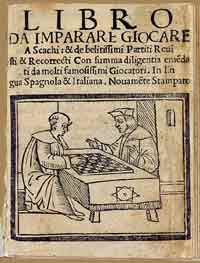 published in 1512 and written by a Portuguese apothecary supposedly named Pedro Damiano, contained not a single reference to the old chess. This book went through 8 reprintings and became the chess bible for the next 50 years. Damiano's book was published in Rome with both Italian and Spanish text. Of it's 124 pages, 89 were concerned with problems of which only one was original. Damiano demonstrated a few openings, gave chess advice and introduced the smothered mate. It also suggests that the game was invented by Xerxes which is why it was known as Axedrez in Spanish published in 1512 and written by a Portuguese apothecary supposedly named Pedro Damiano, contained not a single reference to the old chess. This book went through 8 reprintings and became the chess bible for the next 50 years. Damiano's book was published in Rome with both Italian and Spanish text. Of it's 124 pages, 89 were concerned with problems of which only one was original. Damiano demonstrated a few openings, gave chess advice and introduced the smothered mate. It also suggests that the game was invented by Xerxes which is why it was known as Axedrez in Spanish Ironically, he examines an opening subsequently named after him but which he condemns as losing (1. e4 e5, 2. Nf3 f6?). He also demonstrates Damiano's Mate. Some of his advice includes: - Do not make aimless moves 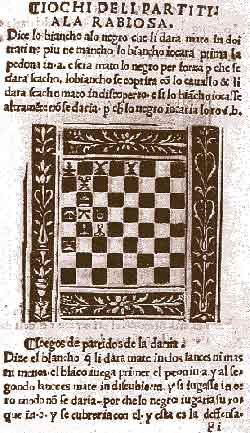 A page from Questo Libro e da Imparare Giocare a Scacch A page from Questo Libro e da Imparare Giocare a ScacchThis site contends that Pedro Damiano is either a Nom de guerre or a case of mistaken identity - that possibly Diogo Barbosa Machado in the 18th century confused Peter Damião with the 11th century bishop of Ostia, Peter Damiani who had, ironically, banned the playing of chess by the clergy. It also maintains that Machado assigned Odemira (Alentejo) to be Damiano's birthplace without any evidence. It notes that the patron saint of medical practitioners (Damiano was an apothecary or a pharmacist) was St.Damiani, making it a logical name for Damiano to usurp and that since using Noms de guerre was a common practice among Portuguese Jews at the time, it also raises the possibility that Damiano was a Jew. 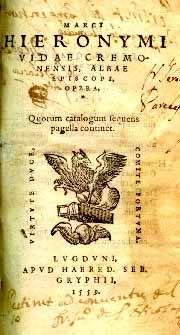
The second important chess publication in the first half of the 16th century wasn't a chess manual, but rather a chess poem. Keeping with the Renaissance spirit, the poem recalls the classical Roman in both it's use of latin and of Roman mythology. It's interesting to note that the poet creates a Goddess of Chess, though not Caissa. The Scacchia Ludus, The Game of Chess, was written by Marcus Hieronymus Vida, Bishop of Alba, in 1513 and published by Vida in 1527 (it was first published in 1525 but Vida's name wasn't credited). In the poem the Roman god Apollo plays Mercury in a game of chess. Vida describes the rules of the game and the pieces used in great detail. Instead of Bishops, Vida employs the term, Sagittifer or Archers; instead of Rooks, he uses Elephas or Elephant. The poem concludes with Mercury's victory after which he seduces a nymph named Scacchis and compensates her by teaching her this godly game and naming it after her: 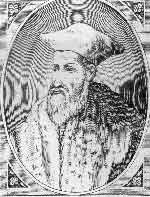
Soon after this, the heavenly victor brought
The game on earth, and first th' Italians taught.
For (as they say) fair Scacchis he espied
Feeding her cygnets in the silver tide,
(Scacchis, the loveliest Seriad of the place)
And as she stray'd, took her to his embrace.
Then, to reward her for her virtue lost,
Gave her the men and chequer'd board emboss'd
With gold and silver curiously inlay'd;
And taught her how the game was to be play'd.
Ev'n now 'tis honour'd with her happy name;
And Rome and all the world admire the game.
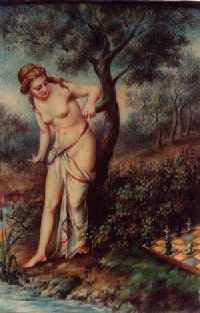 Scacchia ludus was the basis for another poem written by William Jones in 1763. His poem was called Caïssa. While Scacchis may have been the first Goddess of Chess, Caïssa is certainly the most famous and sustaining. In the poem Caïssa, Mars becomes infatuated with a nymph named Caïssa but she does not return the favor and is in fact a bit repulsed by the God of War. Not one to give up the fight, Mars enlists the aid of an ally, Euphron, the God of Sports and Games. Euphon creates the game of chess and designs a beautiful and elaborate board and chess set for Mars to give to Caïssa. In the poem, Mars gains Caïssa's attention this way and teaches her how to play. As the game progresses, Caïssa's resistance wears down and in the end, Mars wins more than just the game. But Caïssa wins eternal fame. 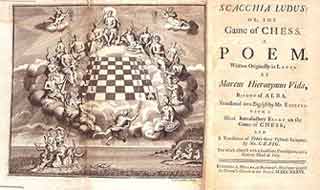
Marcus Hieronymus Vida was an Italian poet, a theologian and the Bishop of Alba. He was born in Cremona in 1485 and died in Alba in 1566. His poem was a favorite of Pope Leo X, an avid chess player. 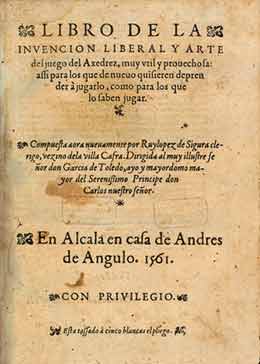 Libro de la Invencion Liberal y Arte del Juego del Axedrez
is the title of the book written by Ruy Lopez de Segura is 1561.
After finding Damiano's book lacking, Ruy Lopez wrote his own book. Lopez dwelt less on problems and more on analysis and openings. The opening named after him [(ECO C60-991) 1. e4 e5 2. Nf3 2Nc6 3. Bb5 ], was first noted in the Gottingen Manuscript around 1490. Lopez, however, provided some analysis of the opening. Although his analysis was objectively poor - Reuben Fine described his book as "hardly worth much by modern standards" - it was the first attempt at systematically organizing and evaluating openings. Besides theory, Ruy Lopez also gave us the term gambit and offered such practical chess advise as making sure your opponent sits facing the sun and waiting to play until after your opponent has had a full, rich meal. Ruy Lopez's book remained the chess bible, making him a rich man in the interim, until it was replaced by a much better offering by Polerio, a difference so great that the German historian, von de Lasa, referred to it as "a step from darkness into light." Libro de la Invencion Liberal y Arte del Juego del Axedrez
is the title of the book written by Ruy Lopez de Segura is 1561.
After finding Damiano's book lacking, Ruy Lopez wrote his own book. Lopez dwelt less on problems and more on analysis and openings. The opening named after him [(ECO C60-991) 1. e4 e5 2. Nf3 2Nc6 3. Bb5 ], was first noted in the Gottingen Manuscript around 1490. Lopez, however, provided some analysis of the opening. Although his analysis was objectively poor - Reuben Fine described his book as "hardly worth much by modern standards" - it was the first attempt at systematically organizing and evaluating openings. Besides theory, Ruy Lopez also gave us the term gambit and offered such practical chess advise as making sure your opponent sits facing the sun and waiting to play until after your opponent has had a full, rich meal. Ruy Lopez's book remained the chess bible, making him a rich man in the interim, until it was replaced by a much better offering by Polerio, a difference so great that the German historian, von de Lasa, referred to it as "a step from darkness into light."
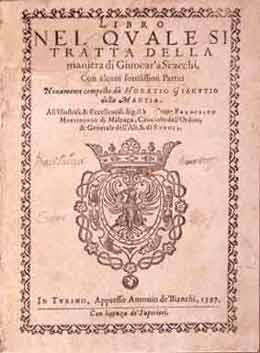
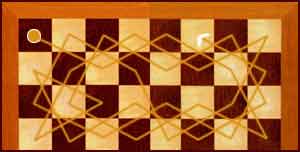 Orazio Gianutio del Mantia, born in Turin 1565, wrote Libro nel quale si tratta della maniera di giucar a scacchi, con alcuni sottilissimi partiti in 1597 and published in Turin, Italy. While it contained some problems and demonstrated 6 openings, it's most interesting feature was it's solution to a half-board knight's tour (shown above). Interestingly, there 2 variations in the King's Gambit named for Orazio Gianutio along with Ruy Lopez: King's Gambit
(Lopez-Gianutio)
C33 KGA: bishop's gamb, Lopez-Gianutio c-gamb
1.e4 e5, 2.f4 exf4 Bc4 f5
C33 KGA: Lopez-Gianutio c-gamb, Hein var.
1.e4 e5, 2.f4 exf4, 3.Bc4 f5, 4.Qe2 Qh4+
In related aside, though not really connected with the Renaissance, but simply because neither Orazio Gianutio nor John Jacob Sarratt are well known nor appreciated, it seems proper to mention that Gianutio was later studied by Surratt in 1817. John Jacob Sarratt was born in 1772 and for the last dozen years of his life was considered the strongest player in England. Because he was the first professional chess teacher, he bears the nickname, Professor of Chess. He was employed for a time as the house professional at Salopian Coffee House in London. There is an opening named for him, the Surratt Attack (1. d4 d5 2. Bf4). He authored several books: A Treatise on the Game of Chess in two volumes was his most famous. Captain Evans was reputed to have been studding this book when his dreamed up the Evan's Gambit. It was named after Pietro Carrera's 1617 book of the same title and was the first book designed for the express purpose of teaching the intricacies of chess. One of Surratt's followers, William Lewis, thought the book was too advanced for most people and was inspired to write a beginner's version called Elements of the Game of Chess which was published in 1822. Surratt went on to author a book on Damaino, Ruy Lopez, and Salvio in 1813, then the book on Gianutio and Selenius in 1817. He died, surprisingly broke, in 1819. While this section deals with the influence of the printing press on chess during the Renaissance, it's necessary to interject an indirect influence. Giulio Cesare Polerio from Lanciano, Italy, never wrote a book, so technically he doesn't belong here. However his manuscripts served two purposes: 1. They indicate how far chess had progressed since Ruy Lopez's treatise, and precisely at what point it stood.
Polerio's impressive work included the first known mention of:
* The Sicilian Defense
1.e4 c5
* The King's Gambit
1.e4 e5 2.f4
In addition to the main line, Polerio investigated:
The Polerio (Muzio) Gambit
1.e4 e5 2.Nc3 Nc6 3.f4 exf4 4.Nf3 g5 5.d4
KGA/Kieseritsky/Polerio defense (C39)
1.e4 e5 2.f4 ef 3.Nf3 g5 4.h4 g4 5.Ne5 Be7
* The Two Knights Defense:
The Fegatello or Fried Liver Attack (Fegatello de Polerio):
1.e4 e5 2.Nf3 Nc6 3.Bc4 Nf6 4.Ng5 d5 5.ed Nxd5 6.Nxf7!? Kxf7 7.Qf3+ Ke6 8.Nc3 Ne7
Polerio Variation of the Two Knights Defense:
1.e4 e5 2.Nf3 Nc6 3.Bc4 Nf6 4.Ng5 d5 5.exd5 Na5 6.Bb5+
*The Dutch Defense
so named for Elias Stein, a Hollander, who analyzed the opening extensively circa 1789
1.d4 f5
*Irregular King's Knight/Latvian:
1.e4 e5 2.Nf3 f5 3.Bc4 fxe4 4.Nxe5 d5
According to Mark Week's (the About.com chess guide and longtime internet chess history influence) Chess Bibliography page , Polerio had three separate Codices [a codex is a book handmade by binding parchment leaves together]: 1570 Polerio (G. C.) Questo libro e di Giulio Cesare Polerio Lancianese al suo comando e del amici à presso 19th cent. copy by Jean Preti of codex (c.1560-80), Biblioth. Nationale, Paris, Manuscrits italiens no 955 (2669 suppl.) 81 leaves. 1590 Polerio (G. C.) Poche fatiche raccolte in diverse parti d'Europa intorno al gioco di scacchi 19th century copy by Coletti of ff. 333a-481a of Codex Boncompagni-Ludovisi N 3 at Rome 150 leaves. (c. 1590) 1594 Polerio (G. C.) Ordini di giuochi degli scacchi indiversi modi 19th century copy by Jean Preti of a manuscript in the Bibliothèque Nationale at Paris, Manuscrits otaliens no 948 (8109-5). 57 lvs Roma 1594 17th Century Chess Literature Just as Ruy Lopez dominated the 16th century in the area of chess literature, the 17th century was focused on Gioacchino Greco. There were, however, several other chess writers worth mentioning: Dr. Alessandro Salvio wrote three books:
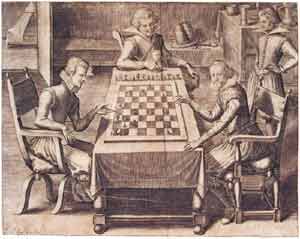 Gustavus Selenus was the nom de plume of August the Younger, Duke of Braunschweig-Lüneburg whose book of openings, Das Schach-Oder König-spiel (Chess or King-play), published in Leipzig in 1616 was the first chess book written in German. Pietro (Peter) Carrera's book, "Il gioco degli scacchi diviso in otto libri ne' quali si insegnano i precetti,le uscite,ed i tratti posticci del gioco e si discorre della vera origine di esso." , published in Militello, Sicily in 1617 was a comprehensive manual, but it had several interesting and original ideas. Already, it showed that people were considering variants to standard chess. Carrera developed a game using an 8 x 10 squared board with an extra two men, one called champions who would possess the combined abilities of the rook and the knight and the other called centaurs who would possess the combined abilities of the bishop and the knight. The rules for this game can be found here. You can actually play a game of Carrera Chess here. 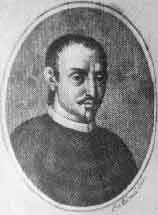 Carrera, writing under the pseudonym, Valentino Vespaio, published a scathing response to Dr. Salvio's Altramente detto IL CAVALIERO ERRANTE DEL SALVIO Sopra il gioco de' Scacchi, con la sua Apologia contra il Carrera, diviso in tre Libri in a pamphlet called Risposta all'Apologia The first chess manual by an Englishman in the English language was The Famous Game of Chesse Play by Arthur Saul in 1652 Being a princely exercise; wherein the learner may profit more by reading of this small booke, then by playing of a thousand mates. Now augmented of many materiall things formerly wanting, and beautified with a threefold methode, viz. of the chesse-men, of the chesse-play, of the chesse-lawes. 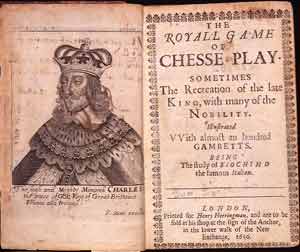 Il Calabrese Il CalabreseGioachino Greco never published a book yet his influence was felt beyond Italy and throughout Europe. Greco was an itinerant chess master, by far the strongest of his day, who left his benefactors and patrons manuscripts of his chess ideas, particularly having to do with gambits, which were published posthumously under a single title. Greco, also called Il Calabrese, lived from 1600 until 1634. In 1656 his manuscripts were published in London by Henry Herringman, the book to be sold at his shop at the sign of the Anchor in the lower walk of the New Exchange. The translation was prepared by Francis Beale with Peter Stent as engraver. It bore the cumbersome title: The Royall Game of Chess-Play. Sometimes The Recreation of the late King, with many of the Nobility. Illustrated with almost an hundred Gambetts. Being the study of Biochimo [Gioachino] the famous Italian A French edition, Le Jeu des Eschets; Traduit de l'Italien de Gioachino Greco Calabrois. was printed in 1669 by Perpingvé in Paris and again in 1689 by Jacques Le Febvre in Paris You can read a long excerpt from the The Royal Game here. Tratato del nobilissimo e militare esercitio de Scacchi nel quale se contengano molti bellisimi Tratti e la vera Scienza di esso Giuoco composto da Cioachino Calabrese, which he dedicated to the Duke of Lorena in 1617. The opening was renamed the Latvian Gambit at the FIDE Congress, 1937 to reflect the work of the Latvian players, such as Karlis Betin, who analyzed this opening deeply. ] Greco demonstrated the maturity of tactics during the Renaissance period of chess and the games offered in his book are quite beautiful. Here are two variations of Greco's Mate: Greco's Mate 1 and Greco's Mate 2View some of Greco's games Other sites offering some of the games of Il Calabrese: page 1 and page 2 This ends the Renaissance Period of Chess. What follows is the Modernese School of Giambattista Lolli, Domenico Ponziani and Ercole Del Rio, the last of the Italian hegemony, usurped by the Syrian Philip Stamma and finally by Francois-Andre Danican Philidor. - but all that's another story. |
